Content
Woody silverfish or leukofoliota is a conditionally edible representative of the mushroom kingdom. It prefers to grow in deciduous forests, in the Central and Northern regions of Russia. It can be used in cooking, as cooked mushrooms have a pleasant taste and aroma.
What does wood silverfish look like?
Wood silverfish is an unusually beautiful species. The cap and leg are bright golden in color, and in the open sun the mushroom seems to glow from the inside, attracting attention. Acquaintance with woody leucophyllum must begin with a description.
Description of the hat
The cap of young mushrooms has a hemispherical shape, which straightens and becomes flat with age. The dry, 9-centimeter golden surface is matte, covered with numerous pointed scales. The bottom is covered with wide light lemon plates and a dense film that descends over time, forming a golden ring.
Leg description
9 cm slightly curved cylindrical leg, hollow, fibrous, painted to match the color of the cap. The snow-white pulp is dense, with a pronounced mushroom smell, the color does not change on the cut.
Wood silverfish is edible or not
Woody leucofoliota is an edible representative of the mushroom kingdom, so it can be used to prepare culinary dishes. Due to the pleasant smell and sweetish taste, mushrooms can be fried, boiled, stewed, frozen. Small species look nice pickled and salted.
Where and how does woody leukofoliota grow
Wood silverfish is an endangered variety listed in the Red Book. Therefore, when going on a mushroom hunt, this must be remembered.
A rare variety prefers deciduous, mixed forests, birch forests and mountain ranges. In the Central and Northern regions, golden mushrooms can be found on stumps, trunks of broad-leaved trees and on their rhizomes.
Doubles and their differences
Woody leukofoliota, like other species, has its counterparts. These include:
- Lovely - grows in temperate climates on broad-leaved trees. You can distinguish it by the free whitish plates, which partially grow together with the leg. Belongs to the 4th group of edibility. Before use and for further preparation, the variety must be boiled in salted water for half an hour.
- Common scaly - common in deciduous and coniferous forests. It grows on stumps, tree trunks and their rhizomes.Variety differences: a wide light cream cap with numerous scales and a long thin leg, colored to match the cap. The variety is edible, from small specimens beautiful and tasty fried, stewed and pickled dishes are obtained.
- Cystoderm - a conditionally edible variety, but I don't use it in cooking. Since it has low taste and an unpleasant pungent odor. The hemispherical hat and long leg are colored red or light brown. The bottom of the cap is covered with wide yellowish plates; there is no ring on the stem.
Conclusion
Woody silverfish or woody leukofoliota is a conditionally edible species listed in the Red Book. It grows in Siberia, the Urals, the Far East on the trunks of deciduous trees. It is impossible to pass by this variety, since it is painted in gold and begins to glow from the inside in the open sun. Despite its rapid disappearance, mushroom pickers use it in cooking, fried, stewed and pickled.















